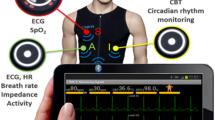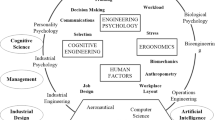Abstract
In this paper, patterns available in human performance during multitasking supervision of a flight simulator are recognized using probabilistic tools. For this purpose, information produced in the system in the form of input baud rate on the one hand, and the information generated by human as the output baud rate on the other hand, are estimated applying the information theory. In the next stage, two quantities are extracted to discover various features related to the human performance in different operational conditions. Finally, these features are provided as the inputs of the Gaussian mixture model (GMM) and in this way, existing separable categories of human performance are distinguished. To validate the applicability of proposed approach, some experimental tests were conducted in which several individuals performed predefined scenarios with varying degrees of autopilot failure in a standard simulator of pilot’s tasks called Multi-Attribute Task Battery. According to the analysis performed on the experimental data, it can be substantiated that when there was a light failure in the autopilot system, subjects maintained the performance in a stable state by trying to increase the output baud rate; however, if the failure was severe, significant performance degradation was observed although the output baud rate caused by subjects increased meaningfully. Moreover, investigation of GMM output in classification of data revealed that this model was able to recognize the distinct functional regions available in the multitasking performance of human with high accuracy. This accuracy has between-days stability, i.e. it does not vary between GMMs that each one trained by data gathered in a specific day. Also, our investigations show that if all data recorded in different days are used to create a GMM, the resulted model has the same level of accuracy.










Similar content being viewed by others
References
Adiguzel Y (2017) Equalizing the information amounts of protein and mRNA by information theory. Biosystems 159:1–11. https://doi.org/10.1016/j.biosystems.2017.05.003
Al-Hashimi O, Zanto TP, Gazzaley A (2015) Neural sources of performance decline during continuous. multitasking. Cortex 71:49–57. https://doi.org/10.1016/j.cortex.2015.06.001
Aquino ALL, Ramos HS, Frery AC, Viana LP, Cavalcante TSG, Rosso OA (2017) Characterization of electric load with information theory quantifiers. Physica A Stat Mech Appl 465:277–284. https://doi.org/10.1016/j.physa.2016.08.017
Bishop CM (2006) Pattern recognition and machine learning, 1st edn. Springer, New York
Boeing (2017) Statistical summary of commercial jet airplane accidents: worldwide operations 1959–2016. Aviation Safety, Boeing Commercial Airplanes, Washington
Camden AN (2015) Theoretical throughput capacity: capabilities of human information processing during multitasking. Wright State University, Dayton
Chang M-C, Shih S-G, Schmitt G (2017) Information theory-based approach for constructability assessment in truss structural systems. Autom Constr 82:84–102. https://doi.org/10.1016/j.autcon.2017.06.010
Christensen JC, Estepp JR, Wilson GF, Russell CA (2012) The effects of day-to-day variability of physiological data on operator functional state classification. Neuroimage 59:57–63 https://doi.org/10.1016/j.neuroimage.2011.07.091
Field A (2013) Discovering statistics using IBM SPSS statistics, 4th edn. Sage, London
Fitts PM (1992) The information capacity of the human motor system in controlling the amplitude of movement. J Exp Psychol Gen 121:262–269
Haslbeck A, Zhang B (2017) I spy with my little eye: analysis of airline pilots’ gaze patterns in a manual instrument flight scenario. Appl Ergon 63:62–71. https://doi.org/10.1016/j.apergo.2017.03.015
Hefron RG, Borghetti BJA (2016) New feature for cross-day psychophysiological workload estimation. In: IEEE international conference on machine learning and applications (ICMLA), California, USA. IEEE, pp 785–790
Hefron RG, Borghetti BJ, Christensen JC, Kabban CMS (2017) Deep long short-term memory structures model temporal dependencies improving cognitive workload estimation. Pattern Recognit Lett 94:96–104. https://doi.org/10.1016/j.patrec.2017.05.020
Jacko JA (2012) Human computer interaction handbook: fundamentals, evolving technologies, and emerging applications, 3rd edn. CRC Press, Boca Raton
Ji Z, Huang Y, Xia Y, Zheng Y (2017) A robust modified Gaussian mixture model with rough set for image segmentation. Neurocomputing 266:550–565. https://doi.org/10.1016/j.neucom.2017.05.069
Kennedy L, Parker SH (2017) Making MATB-II medical: pilot testing results to determine a novel lab-based, stress-inducing task. In: Proceedings of the international symposium on human factors and ergonomics in health care, vol 6, pp 201–208. https://doi.org/10.1177/2327857917061044
Kim JH, Yang X (2017) Applying fractal analysis to pupil dilation for measuring complexity in a process monitoring task. Appl Ergon 65:61–69. https://doi.org/10.1016/j.apergo.2017.06.002
Kim S, Haschke R, Ritter H (2017) Gaussian mixture model for 3-DoF orientations. Robot Auton Syst 87:28–37. https://doi.org/10.1016/j.robot.2016.10.002
Lee S, Rajan S, Jeon G, Chang J-H, Dajani HR, Groza VZ (2017) Oscillometric blood pressure estimation by combining nonparametric bootstrap with Gaussian mixture model. Comput Biol Med 85:112–124. https://doi.org/10.1016/j.compbiomed.2015.11.008
Liu S, Wadeson A, Kim NY, Nam CS (2016) Effects of working memory capacity, task switching, and task difficulty on multitasking performance. In: Proceedings of the Human Factors and Ergonomics Society annual meeting, vol 60, pp 502–506. https://doi.org/10.1177/1541931213601114
MATLAB Primer (2015) The MathWorks, Inc., Natick
Mazloumi A, Kumashiro M, Izumi H, Higuchi Y (2010) Examining the influence of different attentional demands and individuals’ cognitive failure on workload assessment and psychological functioning. Int J Occup Hyg 2:17–24
Nakamura TA et al (2017) Adaptive fault detection and diagnosis using parsimonious Gaussian mixture models trained with distributed computing techniques. J Frankl Inst 354:2543–2572. https://doi.org/10.1016/j.jfranklin.2016.11.024
Oswald FL, Hambrick DZ, Jones LA (2007) Keeping all the plates spinning: understanding and predicting multitasking performance. In: Jonassen DH (ed) Learning to solve complex scientific problems. Lawrence Erlbaum Associates, Mahwah, pp 77–97
Phillips CA, Repperger DW, Kinsler R, Bharwani G, Kender D (2007) A quantitative model of the human–machine interaction and multi-task performance: a strategy function and the unity model paradigm. Comput Biol Med 37:1259–1271
Rasmussen J (1986) Information processing and human–machine interaction: an approach to cognitive engineering, 1st edn. Elsevier Science Ltd,, New York
Redick TS (2016) On the relation of working memory and multitasking: memory span and synthetic work performance. J Appl Res Mem Cogn 5:401–409. https://doi.org/10.1016/j.jarmac.2016.05.003
Santiago-Espada Y, Myer RR, Latorella KA, Comstock JR Jr (2011) The Multi-Attribute Task Battery II (MATB-II) software for human performance and workload research: a user’s guide. Langley Research Center, Virginia
Schneider DI (2013) An introduction to programming using visual basic 2012, 9th edn. Prentice Hall Press, New Jersey
Shannon CE (2001) A mathematical theory of communication. Bell Syst Tech J 27:379–423
Valk PJ, Van Roon DB, Simons RM, Rikken G (2004) Desloratadine shows no effect on performance during 6 h at 8,000 ft simulated cabin altitude. Aviat Space Environ Med 75:433–438
Walters CM (2012) Application of the human–machine interaction model to Multiple Attribute Task Battery (MATB): task component interaction and the strategy paradigm. Wright State University, Dayton
Wang Z, Alahmadi A, Zhu DC, Li T (2016) Causality Analysis of fMRI Data Based on the Directed Information Theory Framework. IEEE Trans Biomed Eng 63:1002–1015
Wang P, Fang W, Guo B (2017) A colored petri nets based workload evaluation model and its validation through Multi-Attribute Task Battery-II. Appl Ergon 60:260–274. https://doi.org/10.1016/j.apergo.2016.11.013
Weyer J (2016) Confidence in hybrid collaboration. An empirical investigation of pilots’ attitudes towards advanced automated aircraft. Saf Sci 89:167–179. https://doi.org/10.1016/j.ssci.2016.05.008
Wickens C (2002) Multiple resources and performance prediction. Theor Issues Ergon Sci 3:159–177. https://doi.org/10.1080/14639220210123806
Wilson GF, Russell CA (2003) Real-time assessment of mental workload using psychophysiological measures and artificial neural networks. Hum Factors 45:635–644. https://doi.org/10.1518/hfes.45.4.635.27088
Acknowledgements
The authors would like to gratefully thank the team of researchers in NASA who developed the Multi-Attribute Task Battery (MATB-II), i.e. the standard simulator of piloting tasks used in this study. Moreover, skilled students of aerospace engineering at Amirkabir University of Technology who voluntarily participated as subjects in the experimental tests should be acknowledged.
Funding
This research did not receive any specific grant from funding agencies in the public, commercial, or not-for-profit sectors.
Author information
Authors and Affiliations
Corresponding author
Additional information
Publisher’s Note
Springer Nature remains neutral with regard to jurisdictional claims in published maps and institutional affiliations.
Rights and permissions
About this article
Cite this article
Mortazavi, M.R., Raissi, K. & Mehne, S.H.H. A probabilistic approach to classification of human performance during interaction with a standard flight tasks simulator. J Ambient Intell Human Comput 10, 3211–3230 (2019). https://doi.org/10.1007/s12652-018-1038-2
Received:
Accepted:
Published:
Issue Date:
DOI: https://doi.org/10.1007/s12652-018-1038-2




